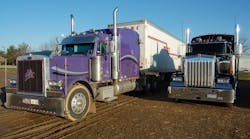According to the U.S. Bureau of Labor Statistics, Millennials make up the majority of the nation’s workforce by the end of this year and comprise 75% of the country’s labor pool by 2030 – and that’s compounding recruiting problems for the trucking industry
“The Baby Boomers are retiring and there are fewer replacement workers for them – that is stifling our ability to address equipment downtime,” explained Mike Jeffress, VP-maintenance for Maverick Transportation, during a panel discussion at the annual Technology & Maintenance Council (TMC) meeting last month.
Yet getting the “next generation” to join trucking’s ranks remains an a difficult proposition, say experts, largely because traditional hiring solutions may not function very well.
For example, a survey conducted last month by Futurestep, a Korn Ferry division specializing in recruitment solutions, found that pay gets trumped by other factors in terms what matters most to Millennial employees – generally defined as those born after 1980:
- The greatest number of respondents (23%) said “the ability to make an impact on the business”
- Next is “a clear path for advancement” (20%) followed by “development and ongoing feedback” (16%).
- Income came in at fourth place at 13%.
When questioning what makes Millennials choose one job over another, more than a third (38%) said “visibility and buy-in to the vision of the organization” while 28% said “a clear path for advancement.” In third place cam “job title and pay” came at 18%.
“This research demonstrates the changing priorities of today’s young workforce,” noted Trish Healy, Futurestep’s VP of RPO operations in North America.
“Where traditionally we might have expected salary to be the number one differentiator for talent choosing their next employer, Millennials are now placing greater value on understanding what a company stands for and how, as employees, they can play a role in growing the organization into a better, stronger brand,” she added.
Charlie Saffro, founder of CS Recruiting, told Fleet Owner that means hiring practices within trucking – as well as for the transportation and logistics industry as a whole – needs to undergo major “behind the scenes” change to attract and keep younger workers.
“Freight transportation is fast-paced and requires a lot of multi-tasking on the part of workers – and that’s exactly what Millennials are looking for,” she explained. “Yet it’s an industry they just don’t know much about so they need to be exposed to the industry’s long-term potential.”
Yet the pace of such “exposure” needs to happen faster, as projected openings in the logistics industry averaging around 270,000 jobs per year in part because baby Boomers are retiring, Saffro noted.
“A path needs to be built for them to follow into a transportation and logistics career, with mentorship along the way,” she added. “Companies need to have their ducks in a row as they bring this next generation into their workforce.”
That’s one reason why truck OEMs are increasing current and future research and development (R&D) spending on in-cab systems, Sandeep Kar, said global director of research, automotive and transportation for global consulting firm Frost & Sullivan.
“While most R&D dollars are still going to powertrains, the highest growth rate in [OEM] R&D spending is within the cabin on driver comforts, connectivity, and convenience,” he explained to Fleet Owner. “The demands on the part of next generation drivers for more health, wellness and well-being focus in their work environment will only continue to grow.”
Futurestep’s Healy added that her firm’s survey also found that nearly half (42%) of those Millennials it polled believe social media is the best tactic for recruitment, followed by “word-of-mouth/networking” (28%) and online talent communities (19%).
“Businesses need to meet these young professionals where they live, which is on social and mobile platforms,” she noted. “These channels are clearly a way of life for this generation, making it imperative that when companies look to hire the best and the brightest, they are creating digital-first recruitment strategies.”
Healy pointed out that using a “multi-channel” approach is essential to attracting, engaging and retaining younger talent with the right skills, experiences, traits and drivers to achieve the company’s strategic objectives.
“Doing so will allow a company to stand out from competitors in the war for top young talent,” she said.



